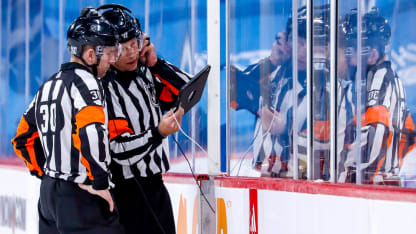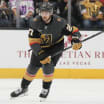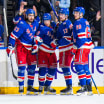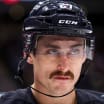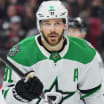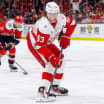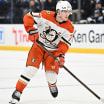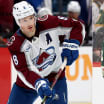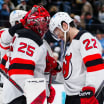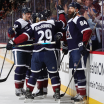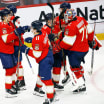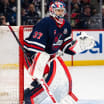MANALAPAN, Fla. -- NHL general managers voted on Tuesday to propose that penalties subject to coach's challenges include delay of game penalties for pucks shot over the glass and certain high-sticking minors.
In addition, the GMs voted to propose small adjustments to several other rules, including tweaks to face-offs that take place after an icing call and stoppages that occur when a player refuses to play the puck, a goalie's mask comes off, and the net is accidentally dislodged.
"Just little fixes to the game," NHL senior executive vice president of hockey operations Colin Campbell said.
The GMs will send their rule-change proposals to the NHL/NHLPA Competition Committee, which is required to vote on them at its next meeting. If approved by the Competition Committee, the proposals go to the NHL Board of Governors for ratification.
There is no date or time yet set for the next Competition Committee meeting, but it typically happens before the end of June.
The hope is to have the rule changes in place for the start of next season.
"The biggest thing is when you go to a game and something will happen on the ice and all the fans can see it was wrong, make sure that moment doesn't happen and try to get it right so it's not only fair for the players on the ice, but fairness for both teams and officiating," Arizona Coyotes general manager Bill Armstrong said at the NHL General Managers meetings. "I think we're just trying to make the game better in small pieces. That's the biggest thing for us."
The most notable is the proposal to expand the coach's challenge.
The GMs want coaches to be allowed to challenge a delay of game penalty for a puck shot over the glass from inside the defensive zone. The penalty will come off the board if the video review clearly shows the puck was deflected by the offensive team or hit the glass on its way out of play.
Through Monday’s games, there have been 234 delay of game penalties called for puck over the glass plays this season. Upon review, the NHL department of hockey operations determined that two of those calls were incorrect. There were six incorrect out of 278 in 1,312 games last season and six out of 254 in 1,312 games in 2021-22.
The expansion of the coach's challenge rule would be to remove a penalty only. There is no mechanism in the proposal to add a penalty.
The GMs also want coaches to be allowed to challenge high-sticking minor penalties they believe are called because the stick causing the infraction did not belong to the team being penalized. Those penalties would be eliminated if there is clear video evidence.
Referees are currently allowed to initiate their own review on four-minute double minors for high sticking to determine if it was friendly fire or a legitimate penalty.
The expansion of the coach's challenge rule would be to remove a penalty only. There is no mechanism in the proposal to add a penalty.
An unsuccessful challenge in both circumstances could result in a 5-on-3 power play for the opponent because the penalty that was challenged would stand and a minor for delay of game will also be assessed per the current coach's challenge rule.
Coach's challenges currently are limited to plays involving goals scored off a potential offside, goalie interference or missed stoppages.
"This is stuff that when you get a quick glimpse on the video you're like, 'Oh, I wish we could do something to get it right," Winnipeg Jets GM Kevin Cheveldayoff. "This is about making sure someone is not gaining an advantage for the wrong reasons."
There are a number of other minor rule change proposals:
--- Nets that have been accidentally dislodged:
Disallowing a team to make changes and giving the attacking team the right to choose which side of the ice it wants the face-off to take place after the defending goalie or skater accidentally causes the net to be dislodged. The current ban on player changes does not apply to the goalies accidentally dislodging the net.
--- Face-offs after icings:
On the face-off following an icing to allow for the attacking player to receive one warning for a face-off violation and on the second infraction he is removed from the face-off. Currently, the attacking player is removed from the face-off on his first violation whereas the defending player is given one warning before he is removed. This is to allow for equity after an icing.
--- Goalies removed for mandatory purposes:
When a goalie is removed from the game for mandatory purposes by the concussion spotter, allowing for the replacement goalie to have time to warm up. Currently, the incoming goalie is not given time to warm up.
--- Face-offs after stoppages when a goalie's mask comes off:
When a stoppage is necessary because a goalie's mask falls off or he takes it off for whatever reason, the face-off should take place in the goalie's defensive zone, his team will not be permitted a line change, and the attacking team will be allowed to choose which side of the ice it wants the face-off.
--- Refusing to play the puck:
Move the face-off to the neutral zone when a defending team refuses to play the puck in its zone after the attacking team played it with a hand pass or high stick. The face-off for this play is currently contested in the zone where the puck is when the whistle blows.
"Just little fixes to the game," NHL senior executive vice president of hockey operations Colin Campbell said.
The GMs also discussed the length of time for 3-on-3 overtime and the style of play in the five-minute extra session, but determined no changes were needed.
They went through examples of possession and control on zone entries to gain clarification on what is considered legal versus what should be offside.
On those plays, the GMs decided the standard being called does not need to be changed because the emphasis needs to be on skilled plays entering the zone, and if they have clear possession it shouldn't matter if their feet cross the blue line before the puck.
"It's the one exception to the rule where you can proceed the puck," NHL director of officiating Stephen Walkom said. "We've always been conservative in this area but it's good to highlight some of the skill in our game."
NHL senior vice president of player safety George Parros gave a presentation to the GMs that he said was "nothing out of the ordinary." Parros said he is encouraging GMs to visit the Department of Player Safety room in the NHL's New York City offices to see how it operates.
"We've always had an open-door policy for our general managers who want to come into our room in New York," Parros said. "We encourage our GMs to come in and check us out, understand the process a little better."
Finally, the GMs discussed urging the officials to be more vigilant in penalizing players who sit on the boards while waiting to go over on a line change because it can be dangerous. The officials give a warning to a player on his first offense and call an unsportsmanlike penalty on the second offense.
"I don't think we're going to have a stopwatch on it, it's a discretionary call and I think our guys are pretty good at applying judgment," Walkom said. "In any situation like that you want to let the coach and the team know and that's usually all we need to do."
